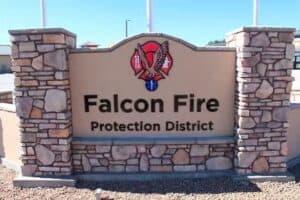Firefighters are always looking for ways to do things better. Whether they are training to improve efficiency on the fireground or learning new emergency medical techniques to provide better patient care, it is a firefighterís nature to figure out the best and most efficient ways to get a job done.The Falcon Fire Protection District recently modified its dispatching protocols to help improve emergency response times. District firefighters are dispatched to emergency incidents by the El Paso County Sheriffís Office. Previously, when dispatchers notified fire district personnel of an incident, it was up to the firefighters to determine which apparatus would respond based on the location of the call as well as their position relative to the incident.Beginning in August, a protocol known as unit-based dispatching went into effect for the Falcon Fire Department. Under this dispatching method, the countyís computer-aided dispatch system uses Global Positioning System information to determine which FFPD unit is closest to an incident. That specific unit is then assigned to the call. The technology is so precise that even if two fire engines are parked next to each other, the apparatus that is physically closest to the incident location ó even if it is only by a few feet ó will be dispatched.Preliminary statistics indicate that response times in the most populated areas of the district have already improved slightly. However, more data is needed before the full impact of unit-based dispatching can be determined.Falcon firefighters train with air ambulance crewAnyone who lives in Falcon or the outlying areas of the fire district is familiar with long travel times to Colorado Springs. Time is a precious commodity in medical emergencies such as strokes or severe trauma injuries, so it is not uncommon for Falconís fire and EMS crews to request an air ambulance to transport critical patients. Depending on the location of the emergency in relation to the closest hospital, using an air ambulance can shorten transport times from 15 to 20 minutes by ground ambulance to 5 to 10 minutes of flight.In September, Falcon firefighters received training from flight crews with UCHealthís LifeLine air ambulance. This training covered how to operate safely around a helicopter, establish safe landing zones, communicate with pilots, best practices for patient loading and more.Changing clocks? Check alarms!The end of daylight saving time means changing clocks throughout the house. This is also a great time to inspect and test smoke alarms and carbon monoxide alarms. These important safety devices cannot function properly unless they are properly maintained.For battery-operated alarms that do not use extended life 10-year batteries, and hard-wired alarms that have battery backups, remove all batteries and replace them with fresh batteries.For all smoke alarms and carbon monoxide alarms:
- Check the manufacture and/or expiration date on the back of the alarm. Replace smoke alarms older than 10 years and carbon monoxide alarms older than seven years, or as recommended by the manufacturer.
- Review the information on the back of the alarm. Most will explain the difference between an actual alarm and a low battery or end-of-service chirp.
- Gently remove any dust that has collected on the alarm.
- Test each alarm by pushing the test button.
- Always notify alarm companies when removing or testing alarms in monitored systems.




